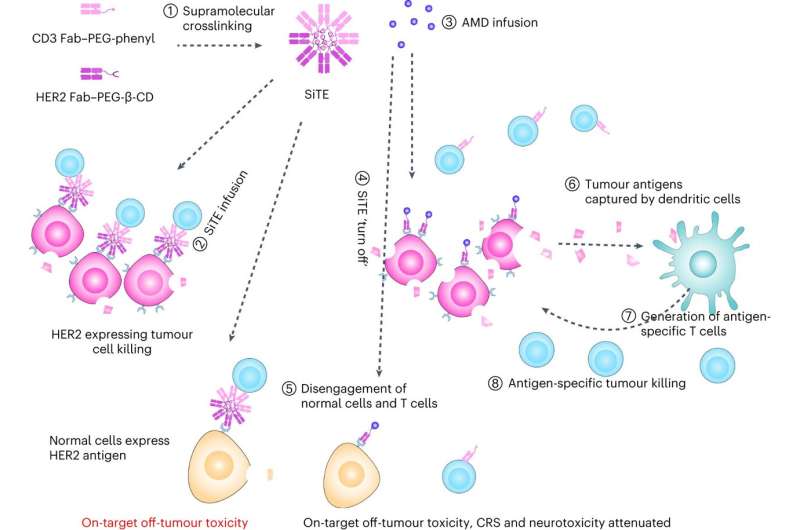This article has been reviewed according to Science X's editorial process and policies. Editors have highlighted the following attributes while ensuring the content's credibility:
fact-checked
peer-reviewed publication
trusted source
proofread
'Switchable' bispecific antibodies pave way for safer cancer treatment

In the ever-evolving battle against cancer, immunotherapy presents a turning point. It began with harnessing the body's immune system to fight cancer, a concept rooted more than a century ago but only gaining significant momentum in recent years.
Pioneering this shift were therapies such as CAR T cell therapy, which reprograms a patient's T cells to attack cancer cells. Within this domain, bispecific T cell engagers, or bispecific antibodies, have emerged as effective treatments for many blood-borne cancers in the clinic and are being evaluated for solid tumor therapy.
These antibodies simultaneously latch onto both a cancer cell and a T cell, effectively bridging the gap between the two. This proximity triggers the T cells to unleash their lethal arsenal, thereby killing the cancer cells.
However, bispecific T cell engagers, like many cancer therapies, face hurdles such as cell-specific targeting limitations, known as on-target off-tumor toxicity, which means the tumor is correctly targeted but so are other healthy cells in the body, leading to healthy tissue damage.
Moreover, bispecific antibodies may also lead to immune system overactivation, a precursor for cytokine release syndrome (CRS), and neurotoxicity.
Now, researchers led by Michael Mitchell of the University of Pennsylvania have found a way to circumvent many of these deleterious effects by developing a bispecific T cell nanoengager that is equipped with an "off switch." Their findings are published in Nature Biomedical Engineering.
"We're excited to show that bispecific antibodies can be tweaked in a way that allows us to tap into their powerful cancer-killing potential without inducing toxicity to healthy tissues," says Mitchell, associate professor of bioengineering at Penn's School of Engineering and Applied Science.
"This new controllable drug-delivery mechanism, which we call switchable bispecific T cell nanoengagers, or SiTEs, adds this switchable component to the antibody via administering an FDA-approved small-molecule drug, amantadine."
Ningqiang Gong, a former postdoctoral researcher in the Mitchell Lab and the first author of the paper, explains that they sought to harness the ability of bispecific antibodies to induce tumor cell toxicity but turn off the therapy to prevent rampant destruction of the non-cancer cells via on-target off-tumor toxicity.
To do this, they considered how these antibodies bind to parts on two types of cells. One arm binds to a specific protein (antigen) on cancer cells, which was HER2, and the other arm binds to the CD3 receptor on T cells.
"We then applied principles from supramolecular chemistry, namely how large proteins can be assembled into a range of structures that can then be disassembled by tiny molecules, to engineer our SiTEs such that they could be broken down once amantadine is introduced," Gong says.
He explains that SiTEs can be composed of two large molecules: PEG-phenyl, which attaches to a part on CD3, and PEG-Beta-CD, which conjugates to HER2. What's unique about the bonding agents they've synthesized is that in the right concentrations of each, amantadine—which has proven pharmaceutically to be safe in treating diseases like Parkinson's since the 1970s and is currently used as a flu prophylactic—showed a high affinity to bond with PEG-Beta-CD.
This affinity is important, as it prompts the detachment of the components, a disassembly that has been observed both in vitro and in vivo.
"Additionally, we found that higher doses of SiTEs can induce an in situ vaccine effect," Gong says, "meaning the immune system is trained to generate a tumor-specific mounted defense to clear all other tumors, and, in the event of a relapse, the body has the tools to similarly tackle future tumors."
"We hope with this technology we could tune the immunotherapy as we need it in the patient," Mitchell says. "If it becomes too aggressive, if it's targeting healthy tissue, we can introduce the small molecule as needed to scale back to make it less toxic for the patient."
Mitchell adds that if it's possible to show that this is tolerable in larger animal models, they can hopefully move to clinical trials after that. As a follow-up, the researchers want to try multiple solid tumor models to see if this strategy can be applied to treat other cell types.
More information: Ningqiang Gong et al, Small-molecule-mediated control of the anti-tumour activity and off-tumour toxicity of a supramolecular bispecific T cell engager, Nature Biomedical Engineering (2024). DOI: 10.1038/s41551-023-01147-6



















